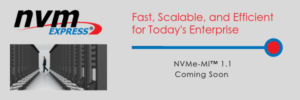
NVMe-MI™ 1.1: Why Manageability is Critical for Today’s Enterprise Storage Demands
BlogBy Peter Onufryk, Management Workgroup Chair and Austin Bolen, Management Workgroup Vice Chair
NVM Express® is innovating to effectively and efficiently service today’s data-intensive storage demands. The NVMe open collection of standards reveal the scores of benefits of non-volatile memory in all types of computing environments from mobile to data centers. Enterprise IT, storage and hyperscale datacenters need robust management to deploy, monitor, maintain, and diagnose servers and solid-state drives (SSDs) to keep applications running with minimal downtime.
The NVMe™ Management Interface (NVMe-MI™) standard defines a command set and architecture for managing NVMe storage, making it possible to discover, monitor, configure, and update NVMe devices in multiple operating environments. NVMe-MI provides an industry standard way for management of NVMe devices in-band (through an operating system) and out-of-band (usually through a BMC, or baseboard management controller). The upcoming revision of the specification, NVMe-MI 1.1, is evolving to meet the growing management needs of the NVMe ecosystem. Anchor features include:
- NVMe Enclosure Management
- In-Band Tunneling of Management Interface Commands
- Support for NVMe Storage Devices with multiple NVM Subsystems
- Support for carrier cards
RASM Equals Design Excellence and Lower TCO
Following the reliability, availability, serviceability, and manageability (RASM) design principals reduces the total cost of ownership (TCO), and NVMe Express specifications are designed from the ground up to deliver not only on high bandwidth and low latency storage access, but also RASM. Manageability is an essential supplement to the traditional elements of reliability, availability, and serviceability.
NVMe end-users and original equipment manufacturers (OEMs) get more control and flexibility through the management features offered by NVMe-MI.
NVMe-MI 1.1 Features and Benefits
The upcoming 1.1 version improves on manageability in several ways. NVMe-MI 1.1 defines a standard for NVMe™ Enclosure Management that works to control storage enclosure elements. NVMe-MI 1.1 now provides a way to access NVMe-MI functionality in-band and adds the ability to manage devices with multiple NVM Subsystems. Lastly, NVMe-MI 1.1 provides the ability to discover and manage carrier cards and the NVMe Storage Devices connected to those cards.
- NVMe Enclosure Management provides the capabilities necessary to monitor and manage enclosure elements such as the power supplies, cooling devices, LEDs, fans, and more.
- The in-band NVMe-MI 1.1 feature provides operating systems (OSs) and applications within the OS, the same level of management functionality as a BMC that are available out-of-band. For example, you gain the ability to manage NVMe Enclosures, the ability to read a drive’s Vital Product Data (VPD), and a more efficient health and temperature monitoring model.
- The new management features for NVMe Storage Devices that contain multiple NVM Subsystem SSDs are key to enabling robust management of NVMe Storage Devices implementations.
- Carrier cards contain expansion connectors that allow a user to plug in one or more NVMe Storage Devices. NVMe-MI 1.1 will allow discovery and management of the carriers and the NVMe Storage Devices connected to them.
For Today and Tomorrow’s Enterprise Needs
NVMe-MI 1.1 further drives home the power of its management capabilities by providing the most critical elements that are required for today’s leading enterprise and hyperscale applications including asset management, temperature monitoring, change management, health monitoring, and more.
NVM Express® helps bring standardization, low latency and connectivity, while bringing all parts of NVMe ecosystem together to provide accelerated storage through the data pipeline. NVM Express® continues to contribute to the acceleration of the data pipeline for the global universe.
The technical work is complete on NVMe-MI 1.1 with wide availability anticipated in the first half of 2019. Experience the power and view the current NVMe-MI on our website.